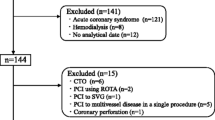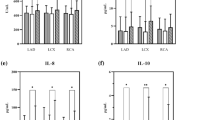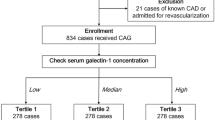Abstract
Percutaneous coronary intervention-related periprocedural myocardial infarction (PCI-RPMI) has now been definitively linked in large data sets to long-term adverse outcomes. It is more likely that the relationship is caused by the underlying predisposing factors that led to the PCI-RPMI, such as plaque vulnerability. Lectin-like oxidized low-density lipoprotein receptor-1 (LOX-1) is involved in multiple phases of vascular dysfunction, including atherosclerotic plaque formation and/or vulnerability. The purpose of this study was to determine whether soluble LOX-1 (sLOX-1) is associated with myocardial necrosis in elective native single-vessel PCI (NSV-PCI). From January 2010 to January 2012, 214 consecutive stable patients undergoing elective NSV-PCI were enrolled. Troponin T, CK and CK-MB were performed to screen for PCI-induced myocardial necrosis after the procedure, and PCI-RPMI was defined as three times the ULN of CK, which was confirmed by the elevation of the CK-MB and troponin T. According to the cardiac biomarkers result, patients were divided into two groups [PCI-RPMI(+) and PCI-RPMI(−)]. sLOX-1 levels were measured in serum by ELISA. Of the 214 patients who underwent NSV-PCI, 33 (15.4 %) patients developed PCI-RPMI. The results of this study showed that among patients undergoing elective NSV-PCI, those with PCI-RPMI had significantly higher circulating sLOX-1 levels than those without (167 ± 89 vs. 99 ± 68 pg/mL; p < 0 0.001). There were high correlations between sLOX-1 levels and CK and CK-MB values (r = 0.677 and r = 0.682, respectively; p < 0.001). Our study demonstrated that circulating sLOX-1 levels were associated with PCI-RPMI, which might predict periprocedural myocardial necrosis in elective NSV-PCI. Importantly, the study speculates that the level of sLOX-1 may help to identify patients at risk for PCI-RPMI before the procedure. sLOX-1 may provide new insights into not only risk stratification, but also therapeutic strategies for elective PCI.


Similar content being viewed by others
References
Rosamond W, Flegal K, Furie K, Go A, Greenlund K, Haase N, Hailpern SM, Ho M, Howard V, Kissela B, Kittner S, Lloyd-Jones D, McDermott M, Meigs J, Moy C, Nichol G, O’Donnell C, Roger V, Sorlie P, Steinberger J, Thom T, Wilson M (2008) American Heart Association Statistics Committee and Stroke Statistics Subcommittee. Heart disease and stroke statistics-2008 update: a report from the American Heart Association Statistics Committee and Stroke Statistics Subcommittee. Circulation 117:e25–e146
Sheldon WC (2001) Trends in cardiac catheterization laboratories in the United States. Catheter Cardiovasc Interv 53:40–45
Thygesen K, Alpert JS (2007) Joint ESC/ACCF/AHA/WHF task force for the redefinition of myocardial infarction. Universal definition of myocardial infarction. J Am Coll Cardiol 50:2173–2195
Califf RM, Abdelmeguid AE, Kuntz RE, Popma JJ, Davidson CJ, Cohen EA, Kleiman NS, Mahaffey KW, Topol EJ, Pepine CJ, Lipicky RJ, Granger CB, Harrington RA, Tardiff BE, Crenshaw BS, Bauman RP, Zuckerman BD, Chaitman BR, Bittl JA, Ohman EM (1998) Myonecrosis after revascularization procedures. J Am Coll Cardiol 31:241–251
Klein LW, Kramer BL, Howard E, Lesch M (1991) Incidence and clinical significance of transient creatine kinase elevations and the diagnosis of non-Q wave myocardial infarction associated with coronary angioplasty. J Am Coll Cardiol 17:621–626
Brener SJ, Lytle BW, Schneider JP, Ellis SG, Topol EJ (2002) Association between CK-MB elevation after percutaneous or surgical revascularization and three-year mortality. J Am Coll Cardiol 40:1961–1967
Dangas G, Mehran R, Feldman D, Stoyioglou A, Pichard AD, Kent KM, Satler LF, Fahy M, Lansky AJ, Stone GW, Leon MB (2002) Postprocedure creatine kinase-MB elevation and baseline left ventricular dysfunction predict one-year mortality after percutaneous coronary intervention. Am J Cardiol 89:586–589
Mehran R, Dangas G, Mintz GS, Lansky AJ, Pichard AD, Satler LF, Kent KM, Stone GW, Leon MB (2000) Atherosclerotic plaque burden and CK-MB enzyme elevation after coronary interventions: intravascular ultrasound study of 2256 patients. Circulation 101:604–610
Kanaparti PK, Brown DL (2000) Relation between coronary atherosclerotic plaque burden and cardiac enzyme elevation following percutaneous coronary intervention. Am J Cardiol 86:619–622
Ricciardi MJ, Davidson CJ, Gubernikoff G, Beohar N, Eckman LJ, Parker MA, Bonow RO (2003) Troponin I elevation and cardiac events after percutaneous coronary intervention. Am Heart J 145:522–528
Sawamura T, Kume N, Aoyama T, Moriwaki H, Hoshikawa H, Aiba Y, Tanaka T, Miwa S, Katsura Y, Kita T, Masaki T (1997) An endothelial receptor for oxidized low-density lipoprotein. Nature 386:73–77
Mehta JL, Chen J, Hermonat PL, Romeo F, Novelli G (2006) Lectin-like, oxidized low-density lipoprotein receptor-1 (LOX-1): a critical player in the development of atherosclerosis and related disorders. Cardiovasc Res 69:36–45
Draude G, Lorenz RL (2000) TGF-beta1 downregulates CD36 and scavenger receptor A but upregulates LOX-1 in human macrophages. Am J Physiol Heart Circ Physiol 278:H1042–H1048
Kume N, Murase T, Moriwaki H, Aoyama T, Sawamura T, Masaki T, Kita T (1998) Inducible expression of lectin-like oxidized LDL receptor-1 in vascular endothelial cells. Circ Res 83:322–327
Minami M, Kume N, Kataoka H, Morimoto M, Hayashida K, Sawamura T, Masaki T, Kita T (2000) Transforming growth factor-beta(1) increases the expression of lectin-like oxidized low-density lipoprotein receptor-1. Biochem Biophys Res Commun 272:357–361
Chen M, Nagase M, Fujita T, Narumiya S, Masaki T, Sawamura T (2001) Diabetes enhances lectin-like oxidized LDL receptor-1 (LOX-1) expression in the vascular endothelium: possible role of LOX-1 ligand and AGE. Biochem Biophys Res Commun 287:962–968
Chen M, Kakutani M, Minami M, Kataoka H, Kume N, Narumiya S, Kita T, Masaki T, Sawamura T (2000) Increased expression of lectin-like oxidized low density lipoprotein receptor-1 in initial atherosclerotic lesions of Watanabe heritable hyperlipidemic rabbits. Arterioscler Thromb Vasc Biol 20:1107–1115
Mitsuoka H, Kume N, Hayashida K, Inui-Hayashiada A, Aramaki Y, Toyohara M, Jinnai T, Nishi E, Kita T (2009) Interleukin 18 stimulates release of soluble lectin-like oxidized LDL receptor-1 (sLOX-1). Atherosclerosis 202:176–182
Murase T, Kume N, Kataoka H, Minami M, Sawamura T, Masaki T, Kita T (2000) Identification of soluble forms of lectin-like oxidized LDL receptor-1. Arterioscler Thromb Vasc Biol 20:715–720
Cominacini L, Pasini AF, Garbin U, Davoli A, Tosetti ML, Campagnola M, Rigoni A, Pastorino AM, Lo Cascio V, Sawamura T (2000) Oxidized low density lipoprotein (ox-LDL) binding to ox-LDL receptor-1 in endothelial cells induces the activation of NF-kappaB through an increased production of intracellular reactive oxygen species. J Biol Chem 275:12633–12638
Li D, Mehta JL (2000) Upregulation of endothelial receptor for oxidized LDL (LOX-1) by oxidized LDL and implications in apoptosis of human coronary artery endothelial cells: evidence from use of antisense LOX-1 mRNA and chemical inhibitors. Arterioscler Thromb Vasc Biol 20:1116–1122
Li D, Mehta JL (2000) Antisense to LOX-1 inhibits oxidized LDL-mediated upregulation of monocyte chemoattractant protein-1 and monocyte adhesion to human coronary artery endothelial cells. Circulation 101:2889–2895
Yoshida H, Kondratenko N, Green S, Steinberg D, Quehenberger O (1998) Identification of the lectin-like receptor for oxidized low-density lipoprotein in human macrophages and its potential role as a scavenger receptor. Biochem J 334(Pt 1):9–13
The Thrombolysis in Myocardial Infarction (TIMI) Trial (1985) Phase I findings. TIMI Study Group. N Engl J Med 312:932–936
Fischman DL, Leon MB, Baim DS, Schatz RA, Savage MP, Penn I, Detre K, Veltri L, Ricci D, Nobuyoshi M et al (1994) A randomized comparison of coronary-stent placement and balloon angioplasty in the treatment of coronary artery disease. Stent Restenosis Study Investigators. N Engl J Med 331:496–501
Erbel R, Haude M, Höpp HW, Franzen D, Rupprecht HJ, Heublein B, Fischer K, de Jaegere P, Serruys P, Rutsch W, Probst P (1998) Coronary-artery stenting compared with balloon angioplasty for restenosis after initial balloon angioplasty. Restenosis Stent Study Group. N Engl J Med 339:1672–1678
Pepine CJ, Holmes DR Jr (1996) Coronary artery stents. American College of Cardiology. J Am Coll Cardiol 28:782–794
Popma JJ, Lansky AJ, Ito S, Mintz GS, Leon MB (1996) Contemporary stent designs: technical considerations, complications, role of intravascular ultrasound, and anticoagulation therapy. Prog Cardiovasc Dis 39:111–128
Oh JK, Shub C, Ilstrup DM, Reeder GS (1985) Creatine kinase release after successful percutaneous transluminal coronary angioplasty. Am Heart J 109:1225–1231
Pauletto P, Piccolo D, Scannapieco G, Vescovo G, Zaninotto M, Corbara F, Cuman G, Chioin R, Casiglia E, Maddalena F et al (1987) Changes in myoglobin, creatine kinase and creatine kinase-MB after percutaneous transluminal coronary angioplasty for stable angina pectoris. Am J Cardiol 59:999–1000
Cavallini C, Savonitto S, Violini R, Arraiz G, Plebani M, Olivari Z, Rubartelli P, Battaglia S, Niccoli L, Steffenino G (2005) Italian ‘atherosclerosis, thorombosis, and vascular biology’ and ‘Society for Invasive Cardiology-GISE’ Investigators. Impact of the elevation of biochemical markers of myocardial damage on long-term mortality after percutaneous coronary intervention: results of the CK-MB and PCI study. Eur Heart J 26:1494–1498
Topol EJ, Ferguson JJ, Weisman HF, Tcheng JE, Ellis SG, Kleiman NS, Ivanhoe RJ, Wang AL, Miller DP, Anderson KM, Califf RM (1997) Long-term protection from myocardial ischemic events in a randomized trial of brief integrin beta3 blockade with percutaneous coronary intervention.EPIC Investigator Group. Evaluation of platelet IIb/IIIa inhibition for prevention of ıschemic complication. JAMA 278:479–484
Ghazzal Z, Ashfaq S, Morris DC, Douglas JS, Marshall JJ, King SB 3rd, Weintraub WS (2003) Prognostic implication of creatine kinase release after elective percutaneous coronary intervention in the pre-IIb/IIIa antagonist era. Am Heart J 145:1006–1012
Kong TQ, Davidson CJ, Meyers SN, Tauke JT, Parker MA, Bonow RO (1997) Prognostic implication of creatine kinase elevation following elective coronary artery interventions. JAMA 277:461–466
Kini A, Marmur JD, Kini S, Dangas G, Cocke TP, Wallenstein S, Brown E, Ambrose JA, Sharma SK (1999) Creatine kinase-MB elevation after coronary intervention correlates with diffuse atherosclerosis, and low-to-medium level elevation has a benign clinical course: implications for early discharge after coronary intervention. J Am Coll Cardiol 34:663–671
Gruberg L, Dangas G, Mehran R, Mintz GS, Kent KM, Pichard AD, Satler LF, Lansky AJ, Stone GW, Leon MB (2002) Clinical outcome following percutaneous coronary interventions in patients with chronic renal failure. Catheter Cardiovasc Interv 55:66–72
Ellis SG, Chew D, Chan A, Whitlow PL, Schneider JP, Topol EJ (2002) Death following creatine kinase-MB elevation after coronary intervention: identification of an early risk period: importance of creatine kinase-MB level, completeness of revascularization, ventricular function, and probable benefit of statin therapy. Circulation 106:1205–1210
Roe MT, Mahaffey KW, Kilaru R, Alexander JH, Akkerhuis KM, Simoons ML, Harrington RA, Tardiff BE, Granger CB, Ohman EM, Moliterno DJ, Lincoff AM, Armstrong PW, Van de Werf F, Califf RM, Topol EJ (2004) Creatine kinase-MB elevation after percutaneous coronary intervention predicts adverse outcomes in patients with acute coronary syndromes. Eur Heart J 25:313–321
Ellis SG, Vandormael MG, Cowley MJ, DiSciascio G, Deligonul U, Topol EJ, Bulle TM (1990) Coronary morphologic and clinical determinants of procedural outcome with angioplasty for multivessel coronary disease. Implications for patient selection. Multivessel Angioplasty Prognosis Study Group. Circulation 82:1193–1202
Nallamothu BK, Chetcuti S, Mukherjee D, Grossman PM, Kline-Rogers E, Werns SW, Bates ER, Moscucci M (2003) Prognostic implication of troponin I elevation after percutaneous coronary intervention. Am J Cardiol 91:1272–1274
Baim DS, Cutlip DE, Sharma SK, Ho KK, Fortuna R, Schreiber TL, Feldman RL, Shani J, Senerchia C, Zhang Y, Lansky AJ, Popma JJ, Kuntz RE (1998) Final results of the Balloon vs Optimal Atherectomy Trial (BOAT). Circulation 97:322–331
Iakovou I, Mintz GS, Dangas G, Abizaid A, Mehran R, Kobayashi Y, Lansky AJ, Aymong ED, Nikolsky E, Stone GW, Moses JW, Leon MB (2003) Increased CK-MB release is a “trade-off” for optimal stent implantation: an intravascular ultrasound study. J Am Coll Cardiol 42:1900–1905
Novack V, Battaglia L, Popma JJ, Cutlip DE (2010) In-hospital and nine-month outcomes among patients with coronary lesions involving a side branch and treated with bare metal stents. Catheter Cardiovasc Interv 76:951–957
Steigen TK, Maeng M, Wiseth R, Erglis A, Kumsars I, Narbute I, Gunnes P, Mannsverk J, Meyerdierks O, Rotevatn S, Niemelä M, Kervinen K, Jensen JS, Galløe A, Nikus K, Vikman S, Ravkilde J, James S, Aarøe J, Ylitalo A, Helqvist S, Sjögren I, Thayssen P, Virtanen K, Puhakka M, Airaksinen J, Lassen JF, Thuesen L, Nordic PCI Study Group (2006) Randomized study on simple versus complex stenting of coronary artery bifurcation lesions: the Nordic bifurcation study. Circulation 114:1955–1961
Topol EJ, Yadav JS (2000) Recognition of the importance of embolization in atherosclerotic vascular disease. Circulation 101:570–580
Fuchs S, Kornowski R, Mehran R, Lansky AJ, Satler LF, Pichard AD, Kent KM, Clark CE, Stone GW, Leon MB (2000) Prognostic value of cardiac troponin-I levels following catheter-based coronary interventions. Am J Cardiol 85:1077–1082
Bonderman D, Teml A, Jakowitsch J, Adlbrecht C, Gyöngyösi M, Sperker W, Lass H, Mosgoeller W, Glogar DH, Probst P, Maurer G, Nemerson Y, Lang IM (2002) Coronary no-reflow is caused by shedding of active tissue factor from dissected atherosclerotic plaque. Blood 99:2794–2800
Jeremias A, Baim DS, Ho KK, Chauhan M, Carrozza JP Jr, Cohen DJ, Popma JJ, Kuntz RE, Cutlip DE (2004) Differential mortality risk of postprocedural creatine kinase-MB elevation following successful versus unsuccessful stent procedures. J Am Coll Cardiol 44:1210–1214
Mizuno O, Hojo Y, Ikeda U, Katsuki T, Fukazawa H, Kurosaki K, Fujikawa H, Shimada K (2000) Assessment of coagulation and platelet activation in coronary sinus blood induced by transcatheter coronary intervention for narrowing of the left anterior descending coronary artery. Am J Cardiol 85:154–160
Herrmann J (2005) Peri-procedural myocardial injury: 2005 update. Eur Heart J 26:2493–2519
Buffon A, Liuzzo G, Biasucci LM, Pasqualetti P, Ramazzotti V, Rebuzzi AG, Crea F, Maseri A (1999) Preprocedural serum levels of C-reactive protein predict early complications and late restenosis after coronary angioplasty. J Am Coll Cardiol 34:1512–1521
Chew DP, Bhatt DL, Robbins MA, Penn MS, Schneider JP, Lauer MS, Topol EJ, Ellis SG (2001) Incremental prognostic value of elevated baseline C-reactive protein among established markers of risk in percutaneous coronary intervention. Circulation 104:992–997
Bhatt DL, Topol EJ (2005) Does creatinine kinase-MB elevation after percutaneous coronary intervention predict outcomes in 2005? Periprocedural cardiac enzyme elevation predicts adverse outcomes. Circulation 112:906–915
Myocardial infarction redefined—a consensus document of The Joint European Society of Cardiology/American College of Cardiology Committee for the redefinition of myocardial infarction (2000) Eur Heart J 21:1502–1513
Li DY, Zhang YC, Philips MI, Sawamura T, Mehta JL (1999) Upregulation of endothelial receptor for oxidized low-density lipoprotein (LOX-1) in cultured human coronary artery endothelial cells by angiotensin II type 1 receptor activation. Circ Res 84:1043–1049
Li L, Sawamura T, Renier G (2003) Glucose enhances endothelial LOX-1 expression: role for LOX-1 in glucose-induced human monocyte adhesion to endothelium. Diabetes 52:1843–1850
Kataoka H, Kume N, Miyamoto S, Minami M, Morimoto M, Hayashida K, Hashimoto N, Kita T (2001) Oxidized LDL modulates Bax/Bcl-2 through the lectinlike Ox-LDL receptor-1 in vascular smooth muscle cells. Arterioscler Thromb Vasc Biol 21:955–960
Moriwaki H, Kume N, Kataoka H, Murase T, Nishi E, Sawamura T, Masaki T, Kita T (1998) Expression of lectin-like oxidized low density lipoprotein receptor-1 in human and murine macrophages: upregulated expression by TNF-alpha. FEBS Lett 440:29–32
Kataoka H, Kume N, Miyamoto S, Minami M, Moriwaki H, Murase T, Sawamura T, Masaki T, Hashimoto N, Kita T (1999) Expression of lectinlike oxidized low-density lipoprotein receptor-1 in human atherosclerotic lesions. Circulation 99:3110–3117
Ueda A, Kume N, Hayashida K, Inui-Hayashida A, Asai M, Kita T, Kominami G (2006) ELISA for soluble form of lectin-like oxidized LDL receptor-1, a novel marker of acute coronary syndrome. Clin Chem 52:1210–1211
Kume N, Kita T (2002) New scavenger receptors and their functions in atherogenesis. Curr Atheroscler Rep 4:253–257
Ishino S, Mukai T, Kume N, Asano D, Ogawa M, Kuge Y, Minami M, Kita T, Shiomi M, Saji H (2007) Lectin-like oxidized LDL receptor-1 (LOX-1) expression is associated with atherosclerotic plaque instability—analysis in hypercholesterolemic rabbits. Atherosclerosis 195:48–56
Li D, Liu L, Chen H, Sawamura T, Mehta JL (2003) LOX-1, an oxidized LDL endothelial receptor, induces CD40/CD40L signaling in human coronary artery endothelial cells. Arterioscler Thromb Vasc Biol 23:816–821
Mehta JL, Li D (2002) Identification, regulation and function of a novel lectin-like oxidized low-density lipoprotein receptor. J Am Coll Cardiol 39:1429–1435
Sugimoto K, Ishibashi T, Sawamura T, Inoue N, Kamioka M, Uekita H, Ohkawara H, Sakamoto T, Sakamoto N, Okamoto Y, Takuwa Y, Kakino A, Fujita Y, Tanaka T, Teramoto T, Maruyama Y, Takeishi Y (2009) LOX-1-MT1-MMP axis is crucial for RhoA and Rac1 activation induced by oxidized low-density lipoprotein in endothelial cells. Cardiovasc Res 84:127–136
Li D, Liu L, Chen H, Sawamura T, Ranganathan S, Mehta JL (2003) LOX-1 mediates oxidized low-density lipoprotein-induced expression of matrix metalloproteinases in human coronary artery endothelial cells. Circulation 107:612–617
Hayashida K, Kume N, Murase T, Minami M, Nakagawa D, Inada T, Tanaka M, Ueda A, Kominami G, Kambara H, Kimura T, Kita T (2005) Serum soluble lectin-like oxidized low-density lipoprotein receptor-1 levels are elevated in acute coronary syndrome: a novel marker for early diagnosis. Circulation 112:812–818
Yamashita H, Ehara S, Yoshiyama M, Naruko T, Haze K, Shirai N, Sugama Y, Ikura Y, Ohsawa M, Itabe H, Kataoka T, Kobayashi Y, Becker AE, Yoshikawa J, Ueda M (2007) Elevated plasma levels of oxidized low-density lipoprotein relate to the presence of angiographically detected complex and thrombotic coronary artery lesion morphology in patients with unstable angina. Circ J 71:681–687
Zhao ZW, Zhu XL, Luo YK, Lin CG, Chen LL (2011) Circulating soluble lectin-like oxidized low-density lipoprotein receptor-1 levels are associated with angiographic coronary lesion complexity in patients with coronary artery disease. Clin Cardiol 34:172–177
Makita Z, Vlassara H, Cerami A, Bucala R (1992) Immunochemical detection of advanced glycosylation end products in vivo. J Biol Chem 267:5133–5138
Chen JW, Zhou SB, Tan ZM (2010) Aspirin and pravastatin reduce lectin-like oxidized low density lipoprotein receptor-1 expression, adhesion molecules and oxidative stress in human coronary artery endothelial cells. Chin Med J (Engl) 123:1553–1556
Conflict of interest
None.
Author information
Authors and Affiliations
Corresponding author
Rights and permissions
About this article
Cite this article
Balin, M., Çelik, A., Kobat, M.A. et al. Circulating soluble lectin-like oxidized low-density lipoprotein receptor-1 levels predict percutaneous coronary intervention-related periprocedural myocardial infarction in stable patients undergoing elective native single-vessel PCI. J Thromb Thrombolysis 34, 483–490 (2012). https://doi.org/10.1007/s11239-012-0770-2
Published:
Issue Date:
DOI: https://doi.org/10.1007/s11239-012-0770-2




